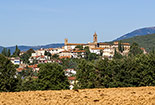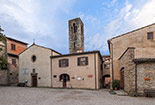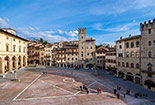LATERINA
a village in Valdarno built on a 14th century castle
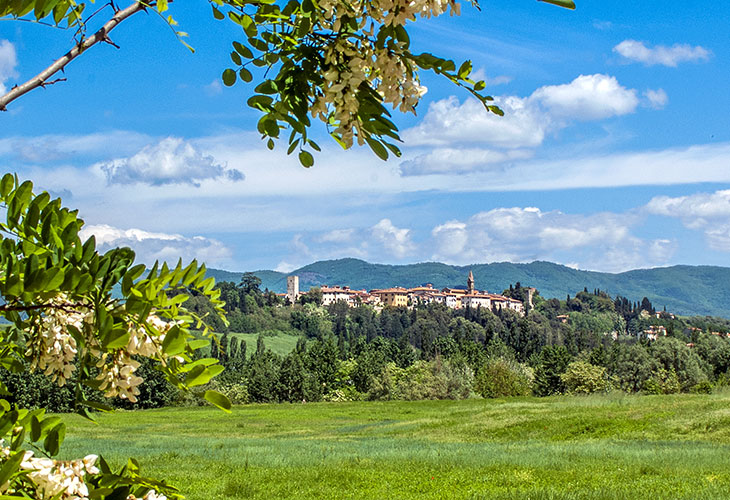
Texts and photos by Alessandro Ferrini ©
41 accurately described images of Laterina and the surrounding area. Click to enlarge
Laterina, a village on the right bank of the Arno
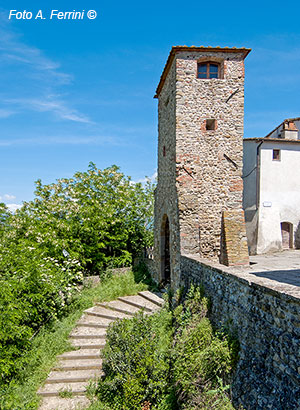 The origins of Laterina date back to a castle built by the Bishopric of Arezzo in the 11th century. From the height on which it was placed, the underlying course of the Arno could be controlled. Due to its dominant position and its proximity to the border between the territories subjected to Arezzo and Florence, the castle was much disputed between these two cities. In the 1920s, the bishop of Arezzo, Guidi Tarlati, had the castle completely destroyed, which at that time was under the control of the Ubertini. Once the power of the Tarlati ended, the new bishop, Boso degli Ubertini, had the Laterina Castle rebuilt, equipping it with new walls and towers, the ones we can see today. He also began the construction of the Rocca, a small defensive fortress. However, this work was completed by the Florentine Republic when in 1384 it definitively acquired dominion over the place. It was in this castle in the middle between the two territories that the contract was signed with which the people of Arezzo sold themselves to the Florentines.
The Arno that flows on the narrow plain next to Laterina is "free" in this section. It has just come out of the Ponte Buriano La Penna reservoir and after a few hundred meters beyond the town it enters the Bandella Dam (better known as the Levane Dam from the name of the village where the dam on the river is located). We pass over this second reservoir with the Romito Bridge located on the road that from the town crosses the Regional Road that connects Arezzo with Montevarchi and San Giovanni Valdarno. From the Ponte del Romito, observing the beautiful stretch of water towards the mountain, we see a bridge stump on the left bank of the Arno. It is the original Ponte del Romito, a medieval structure with several arches probably similar to Ponte Buriano.
Returning to Laterina, coming from the road that
The origins of Laterina date back to a castle built by the Bishopric of Arezzo in the 11th century. From the height on which it was placed, the underlying course of the Arno could be controlled. Due to its dominant position and its proximity to the border between the territories subjected to Arezzo and Florence, the castle was much disputed between these two cities. In the 1920s, the bishop of Arezzo, Guidi Tarlati, had the castle completely destroyed, which at that time was under the control of the Ubertini. Once the power of the Tarlati ended, the new bishop, Boso degli Ubertini, had the Laterina Castle rebuilt, equipping it with new walls and towers, the ones we can see today. He also began the construction of the Rocca, a small defensive fortress. However, this work was completed by the Florentine Republic when in 1384 it definitively acquired dominion over the place. It was in this castle in the middle between the two territories that the contract was signed with which the people of Arezzo sold themselves to the Florentines.
The Arno that flows on the narrow plain next to Laterina is "free" in this section. It has just come out of the Ponte Buriano La Penna reservoir and after a few hundred meters beyond the town it enters the Bandella Dam (better known as the Levane Dam from the name of the village where the dam on the river is located). We pass over this second reservoir with the Romito Bridge located on the road that from the town crosses the Regional Road that connects Arezzo with Montevarchi and San Giovanni Valdarno. From the Ponte del Romito, observing the beautiful stretch of water towards the mountain, we see a bridge stump on the left bank of the Arno. It is the original Ponte del Romito, a medieval structure with several arches probably similar to Ponte Buriano.
Returning to Laterina, coming from the road that 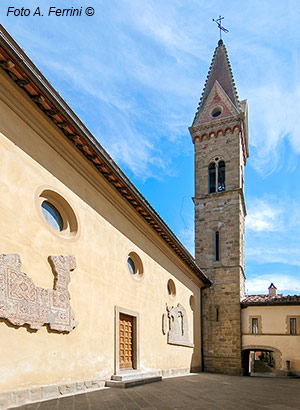 comes from San Giustino Valdarno and Il Borro, the town appears at the top. In the area from which we have this view there are some cliffs, a geological conformation in clay that characterizes the Valdarno belt that runs along the Strada Setteponti. Their beautiful orange color contrasts with the surrounding green. To go up to the town we can take the first detour to the left that we meet. In this way we will enter the village from Porta di Ghianderino, better known as Porta Fredda (it faces north), located under a 14th century tower, perhaps the most obvious and original architectural element of the second castle.
The town has a narrow and elongated plan that develops along a main street. At one end of this is Torre Guinigi, also from the fourteenth century but more modified over the centuries. A door below this leads to a small public park, once an elegant stately garden.
Along the street we arrive in the church square where the fifteenth-century Palazzo del Podestà also faces, a symbol of Florentine power, characterized by many coats of arms placed on its facade. The adjacent church is documented from the end of the 12th century when it inherited the title to Saints Ippolito and Cassiano from a parish distant from the castle built in the 8th century in a place called Le Pievi where there had been a Roman villa. Mosaics belonging to this building are now on display on the outside right wall of the church. This, after being damaged by an earthquake, underwent a substantial rebuilding in the 1920s. Inside, with three naves, you can see interesting works of art from the 15th and 16th centuries. As soon as you enter, on the left, we can see a beautiful fresco referable to the last years of the fifteenth century showing the Virgin and Child among saints. Behind the main altar and in front of a stained glass window where the titular saints of the church are represented, there is an early sixteenth-century wooden crucifix attributed to Baccio da Montelupo or his workshop. Still from the same period we still have another Madonna and Child on a table between Saints Ippolito and Cassiano by the Florentine Domenico Puligo. A Madonna del Rosario del Cosci can be dated to around 1580,
comes from San Giustino Valdarno and Il Borro, the town appears at the top. In the area from which we have this view there are some cliffs, a geological conformation in clay that characterizes the Valdarno belt that runs along the Strada Setteponti. Their beautiful orange color contrasts with the surrounding green. To go up to the town we can take the first detour to the left that we meet. In this way we will enter the village from Porta di Ghianderino, better known as Porta Fredda (it faces north), located under a 14th century tower, perhaps the most obvious and original architectural element of the second castle.
The town has a narrow and elongated plan that develops along a main street. At one end of this is Torre Guinigi, also from the fourteenth century but more modified over the centuries. A door below this leads to a small public park, once an elegant stately garden.
Along the street we arrive in the church square where the fifteenth-century Palazzo del Podestà also faces, a symbol of Florentine power, characterized by many coats of arms placed on its facade. The adjacent church is documented from the end of the 12th century when it inherited the title to Saints Ippolito and Cassiano from a parish distant from the castle built in the 8th century in a place called Le Pievi where there had been a Roman villa. Mosaics belonging to this building are now on display on the outside right wall of the church. This, after being damaged by an earthquake, underwent a substantial rebuilding in the 1920s. Inside, with three naves, you can see interesting works of art from the 15th and 16th centuries. As soon as you enter, on the left, we can see a beautiful fresco referable to the last years of the fifteenth century showing the Virgin and Child among saints. Behind the main altar and in front of a stained glass window where the titular saints of the church are represented, there is an early sixteenth-century wooden crucifix attributed to Baccio da Montelupo or his workshop. Still from the same period we still have another Madonna and Child on a table between Saints Ippolito and Cassiano by the Florentine Domenico Puligo. A Madonna del Rosario del Cosci can be dated to around 1580, 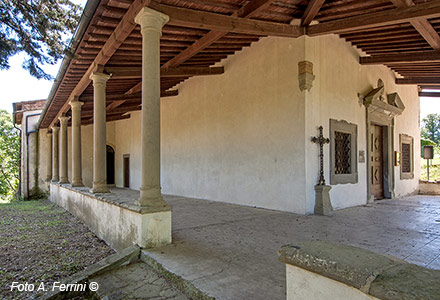 the stage name of the Florentine Giovanni Balducci.
In Laterina there are two other interesting sacred buildings: the Oratory of San Biagio and the Church of Santa Maria della Neve. Here too, particularly in the second, valuable works of art are preserved. A few steps from the back of the Church of Sant’Ippolito e Cassiano is La Rocca, mentioned above.
Laterina is the starting point of two interesting historical naturalistic itineraries. Both hold the course of the Arno as a common thread. One, going up the right bank of the river, leads to the small but elegant village of La Penna built on the remains of a medieval castle built on a rocky promontory overlooking the river and whose fascinating ruins are still visible. The second, completely flat, is held on the left bank of the Arno in the opposite direction to the other and between woods and fields leads us to the Sanctuary of Santa Maria in Valle, a 17th century religious building in its current structure, but built on a previous oratory.
Both paths are illustrated and described in the final pages of the photo gallery of this web section.
the stage name of the Florentine Giovanni Balducci.
In Laterina there are two other interesting sacred buildings: the Oratory of San Biagio and the Church of Santa Maria della Neve. Here too, particularly in the second, valuable works of art are preserved. A few steps from the back of the Church of Sant’Ippolito e Cassiano is La Rocca, mentioned above.
Laterina is the starting point of two interesting historical naturalistic itineraries. Both hold the course of the Arno as a common thread. One, going up the right bank of the river, leads to the small but elegant village of La Penna built on the remains of a medieval castle built on a rocky promontory overlooking the river and whose fascinating ruins are still visible. The second, completely flat, is held on the left bank of the Arno in the opposite direction to the other and between woods and fields leads us to the Sanctuary of Santa Maria in Valle, a 17th century religious building in its current structure, but built on a previous oratory.
Both paths are illustrated and described in the final pages of the photo gallery of this web section.




